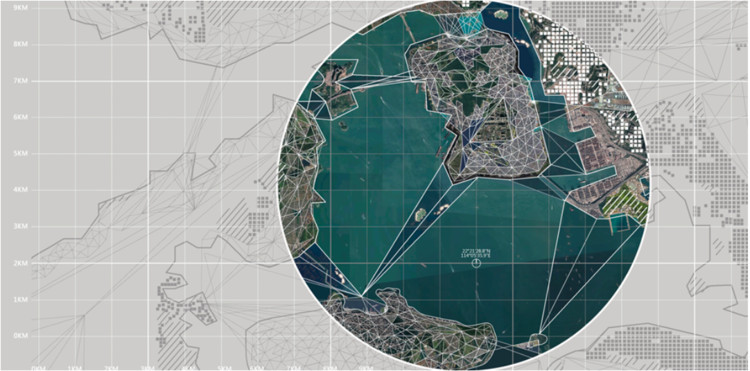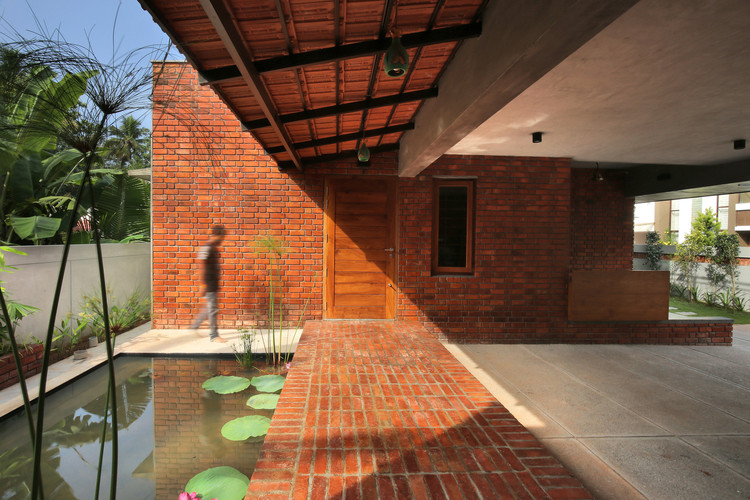
ArchDaily has created a list of best articles, news and projects that address everything you need to know about brick.


ArchDaily has created a list of best articles, news and projects that address everything you need to know about brick.

What happens when the sensor-imbued city acquires the ability to see – almost as if it had eyes? Ahead of the 2019 Shenzhen Biennale of Urbanism\Architecture (UABB), titled "Urban Interactions," ArchDaily is working with the curators of the "Eyes of the City" section at the Biennial to stimulate a discussion on how new technologies – and Artificial Intelligence in particular – might impact architecture and urban life. Here you can read the “Eyes of the City” curatorial statement by Carlo Ratti, the Politecnico di Torino and SCUT.
The recent ‘Greater Bay Area’ (GBA) initiative has led to a renewed interest in the supra-urban and regional or territorial planning scale by the spatial planning professions, urbanists and strategic spatial planners globally. The emergence of ‘mega’ urban-scapes and their regional agglomeration into urbanised areas of over 70 million – at least an order of magnitude larger than has ever been planned before - has reframed many conventional challenges of the spatial planning agenda. With the mega region in formation, a new necessity emerges, that being the investigation of the dynamic, morphogenetic and ecosystemic properties specific to specific regional conditions. Simply, the integration of eleven significantly sized cities and their corresponding metropolitan hinterlands, three special economic or administrative regions, three currencies, and three (or more) different cultural groups into one urban regional entity is a massive undertaking. At present aside from the governance and policy intentions this has primarily resulted in an infrastructural planning approach, one that utilizes a systemic top-down approach that seeks to provide the connective tissues and reticules, as well as civic and economic systems that mobilise people, capital and goods in such a vast region. This approach is akin to the smart city models which seek to enfold all aspects of civic life within infrastructure systemic control paradigms. But in reality, given the scope and scale of this undertaking the modalities of planning in the GBA need to shift from an extensive planned realm in which every part coheres to a plan, to one of a differentiated field in which different intensities arise as an effect of their urban eco-system integration (or its lack of). This clearly needs new approaches, concepts and models of planning that can deal with these regional issues in dynamic, open-ended ways that can foster new modalities of planning.

Often recognized as one of the most widespread constructive materials in the world, brick is, with no doubts, very versatile, low-cost and easily applied. Although it usually used in vertical surfaces, it also presents excellent properties when applied to horizontal ones, like floors.
EGGER places an emphasis on the topic of digitalisation in the new collection. "We know that collections with real samples are important, but no longer sufficient, in order to advise customers optimally. This is why we have complemented our service offering with the new collection app, which combines many helpful features. This means that customers always have the collection digitally at hand", says Head of Marketing at EGGER Hubert Höglauer, summarising the comprehensive service.
Best known for his theory of mobile architecture and his spatial city project, Yona Friedman has passed away at 96, as was announced in his Instagram account this morning. The Hungarian born French architect and theorist was one of the most influential figures of the profession in the late 1950s and early 1960s.

We are continuing our five-year-long tradition of celebrating “The Best Architecture Drawings of the Year.” The 2019 edition sees a carefully-curated collection of architectural drawings with a wide variety of techniques and representations, all orientated towards a common goal of sharing architectural ideas, visions, and designs.

Entitled Becoming Xerophile, Cooking Sections and AKT II have developed a zero-water desert garden, part of the first Sharjah Architecture Triennial in UAE, curated by Adrian Lahoud. The installation explores the introduction of desert landscapes in the urban fabric of the city and everyday life.
The AI & Architecture at the Pavillon de l'Arsenal in Paris, France was scheduled to be open for the past couple of months, showcasing work by Stanislas Chaillou on generative design and machine learning. However, due to the global pandemic, people were able to virtually explore the ideas through a series of interviews and a virtual tours. The work explored current scales of experimentation: plans, elevations, structures and perspectives in which AI could already make a contribution, whether real or speculative.

A draft of an executive order titled “Making Federal Buildings Beautiful Again” is moving forward towards possible signing by President Donald J. Trump. The proposed document favors Classical Greco-Roman design typologies for federal buildings in Washington, DC and elsewhere throughout the USA. This order would revise the current rules that regulate the design of federal buildings contracted through the GSA (General Services Administration — a Federal agency managing the construction, administration, and upkeep of US Government buildings and real estate). It was initiated by the National Civic Art Society, a Washington, DC based nonprofit organization that disapproves of what the US government has been building for decades. According to the New York Times, the chairman of the National Civic Art Society, Mr. Marion Smith, stated that: “For too long architectural elites and bureaucrats have derided the idea of beauty, blatantly ignored public opinions on style, and have quietly spent taxpayer money constructing ugly, expensive, and inefficient buildings.”

Design and the City is a podcast by reSITE, raising questions and proposing solutions for the city of the future. In the third episode, "When East meets West", Yoko Choy reflects upon bringing together the knowledge and insights of the east and the west and translating them into a common creative language. Joining Choy are curator Beatrice Leanza of Lisbon’s MAAT Museum as well as UK and China-based WallaceLiu founders, Jamie Wallace and Jee Liu.
_KASA.jpg.jpg?1582190572)
The Russian Pavilion has announced its first list of contributors for the 2020 Venice Biennale. Selected after an open call, a new generation of architects will set up a temporary office within the pavilion, from May to November, creating an open workspace to plan the on-going architectural transformation.
.jpg?1456012027)
Sometimes referred to as “the leading environmental architect of our time,” in his roles as architect, designer, author, educator and social leader, William McDonough (born 20 February 1951) has provided a renewed look at the things that we make and their impact on both our bodies and the world. Through his Cradle to Cradle philosophy, McDonough’s buildings are designed to function for a predetermined lifespan, after which they can be broken down into their various parts whose core elements can be used anew to solve a different design problem.

Held each year by the IE School of Architecture and Design, Venture Day provides start-ups a chance to pitch their ideas to a panel of judges. Part of the IE accelerator program Venture Lab, the high-pressure competition gives participants just five minutes to give concise, impactful presentations. This pitch is followed by a Q&A session, after which the winners are selected by a jury.

Louis Kahn (February 20th 1901 – March 17th 1974) was one of the United States' greatest 20th century architects, known for combining Modernism with the weight and dignity of ancient monuments. Though he did not arrive at his distinctive style until his early 50s, and despite his death at the age of just 73, in a span of just two decades Kahn came to be considered by many as part of the pantheon of modernist architects which included Le Corbusier and Mies van der Rohe.

The vast history of the United States involving migration, the great variety of climates and the mix of cultures, has built a very diverse urban and architectural landscape. Despite this, there is a large number of historic buildings that – unfortunately, as in many other countries – are in the state of decay due to poor maintenance, which attracts developers.

Ivy Tech and Cummins have selected IwamotoScott Architecture of San Francisco to create the new Ivy Tech Columbus campus building. The College anticipates breaking ground in 2020 and taking occupancy in 2022.

Henning Larsen has unveiled its vision for Brouck’R, a city block transformation project facing Brussels’ busy Place de Brouckère. Inspired by traditional and contemporary heritage, the proposal generates a 21st-century, vibrant, mixed-use destination in the city center.

A team of five firms have come together to design the first large-scale timber building in Western Australia. Lyons Architecture is working with Officer Woods, The Fulcrum Agency, STH and Aspect Studios on the new academic building at Murdoch University in Perth. Constructed from locally sourced timber, the four-story project will include offices, learning spaces, and informal gathering areas.

Japanese mass housing from the 1960s is a fascinating cross-cultural experiment that merged Western and Soviet modernist typologies with traditional Japanese elements. Once a symbol of a new “modernized” way of life, it has since become a burden for Japanese society. Current living conditions in these housing estates are unsuitable for elderly residents and have given rise to the phenomena of kodokushi—lonely, unnoticed deaths inside of the apartments. Researcher and photographer Tatiana Knoroz explores the tragic fate of this modernist project in her essay for Strelka Mag.

Design practice Conrad Gargett have created a proposal for a sculptural mixed-use complex in the Brisbane suburbs of Queensland, Australia. Sited in Lutwyche, the project aims to become an integrated development built to accommodate an ageing population in Queensland. Dubbed Lamington Markets, the design overlays public amenities and commercial spaces with local recreation space.

How do street art practices resonate through the digital world, and how do we trace such resonance back to the street? More generally, what happens when the sensor-imbued city acquires the ability to see – almost as if it had eyes? Andrea Baldini (Nanjing University) reflects on the role that the Internet, and social networks, in particular, have had in boosting the circulation of graffiti and street art and, in turn, their communicative and denouncing power.
For the 2019 Shenzhen Biennale of Urbanism\Architecture (UABB), titled "Urban Interactions," (21 December 2019-8 March 2020) ArchDaily is working with the curators of the "Eyes of the City" section to stimulate a discussion on how new technologies might impact architecture and urban life. The contribution below is part of a series of scientific essays selected through the “Eyes of the City” call for papers, launched in preparation of the exhibitions: international scholars were asked to send their reflection in reaction to the statement by the curators Carlo Ratti Associati, Politecnico di Torino and SCUT, which you can read here.

Architects Julie Smith-Clementi and Frank Clementi have changed the built environment of Southern California and Los Angeles for over three decades. Together, the duo recently launched Smith-Clementi, a new multidisciplinary design practice working at the intersection of urbanism, architecture and product design. Following a "plates to parks" design philosophy, the duo is transforming the built environment at multiple scales.

Framlab, an innovation studio based in Bergen and New York City has created Glasir, a community-based system for urban farming. The proposed modular structure relies on aeroponic growth systems to provide local products.